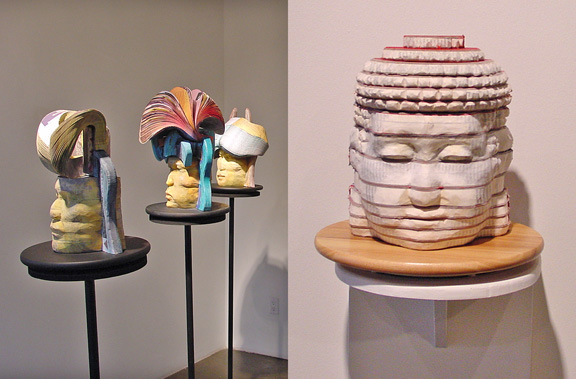
Long-Bin Chen's majestic works are inextricably tied to issues central to contemporary society: his sculptural forms are fashioned out of cultural debris of our information society. Through the skillful manipulation of a band saw, out-of-date books, newspapers, magazines, and computer paper are transformed into art works that from a distance look like wood or marble. But his seemingly monumental forms are ironically built out of paper, and on close inspection, the reading materials fit together like pieces of a puzzle can be dismantled to their original form.
Patricia Eichenbaum Karetzky
From her essay, Long-Bin Chen: Content in Forms
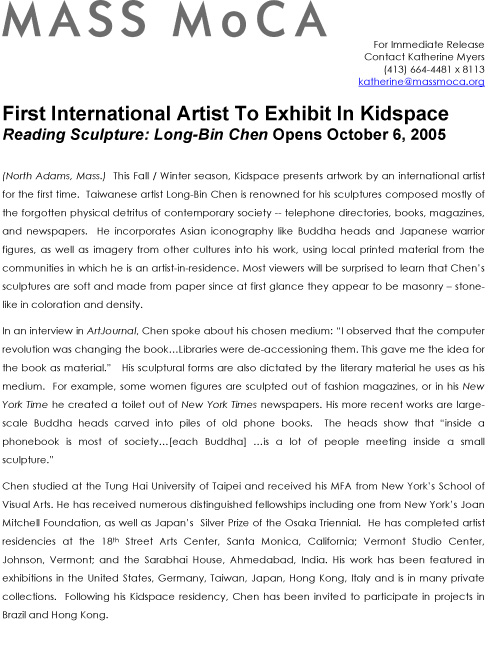
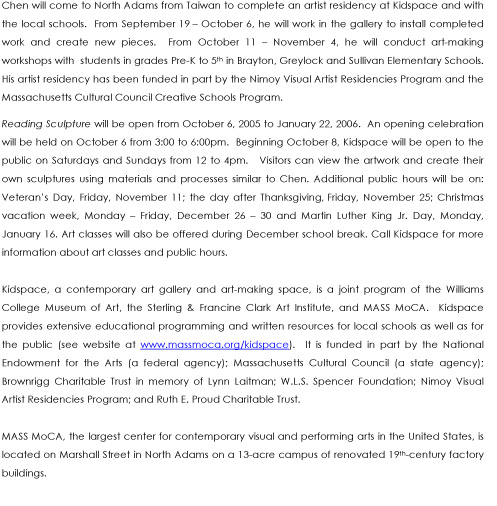
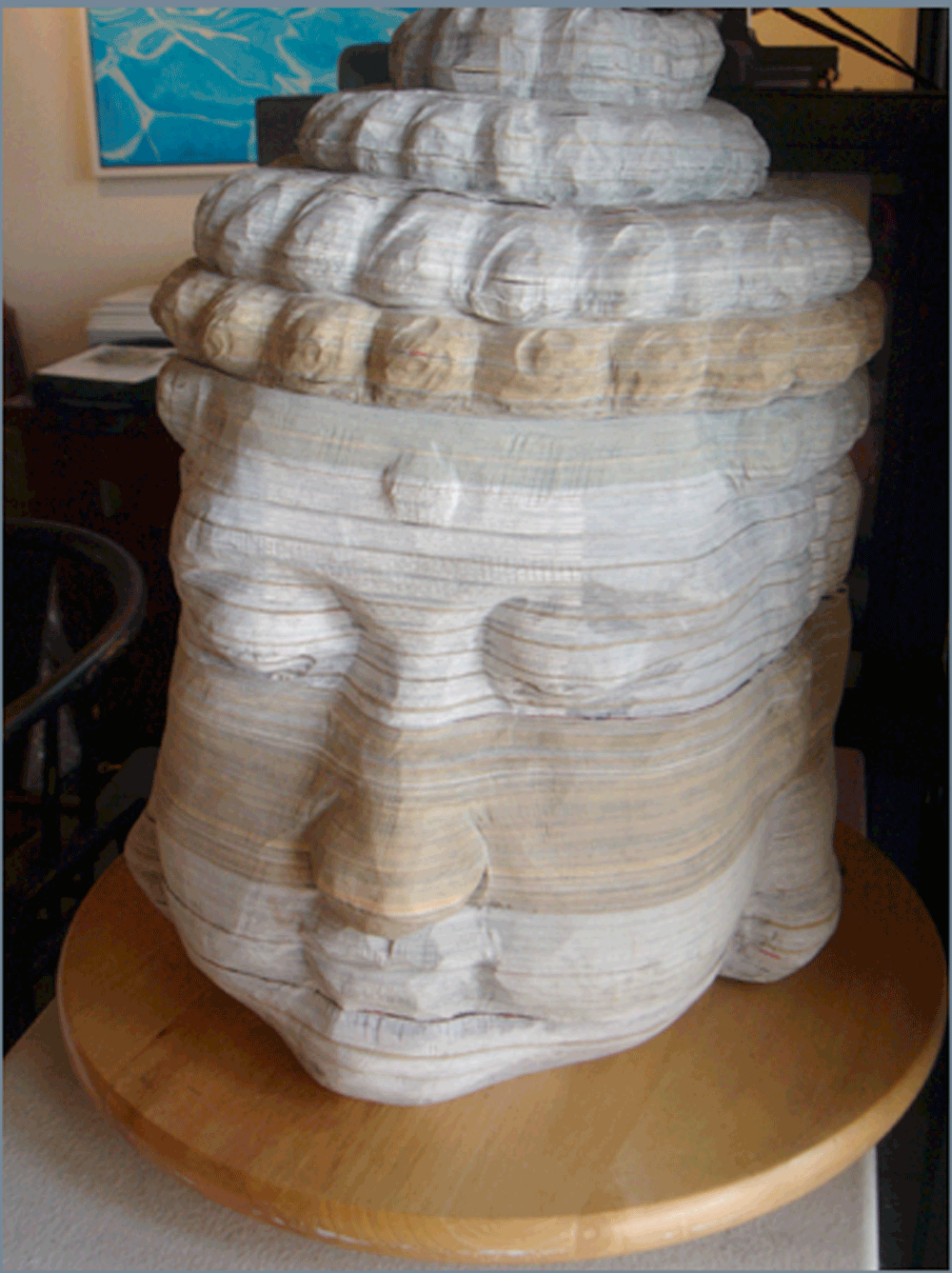
Sleeping Buddha, Sculpted Bridal Magazines, 2003, 12" x 9" 9"
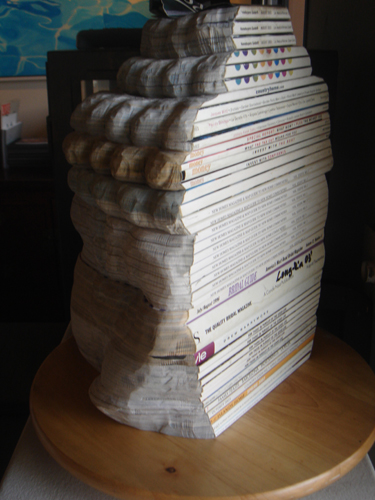
Sleeping Buddha (side view), Scultped Bridal Magazines, 2003, 12" x 9" x 9"
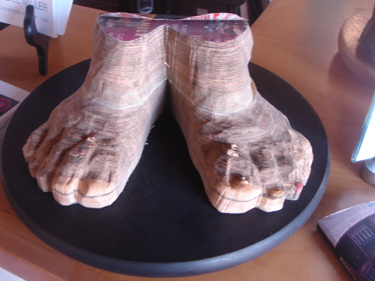
Feet, Sculpted Los Angeles Phonebooks, 2003, 3" x 10" x 9"
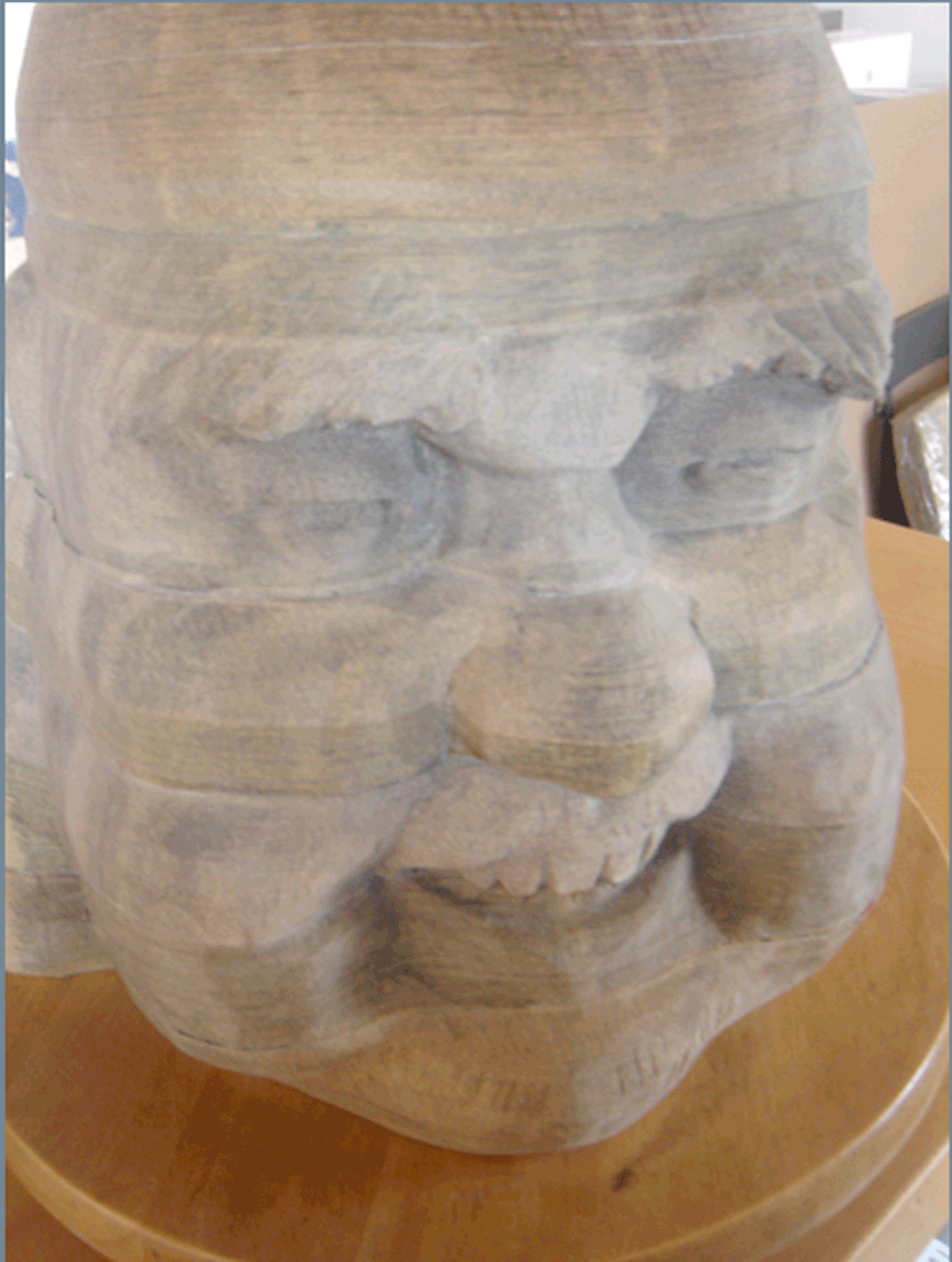
Happy Buddha, Sculpted Los Angeles Phonebooks, 2003, 9.5" x 11" x 8"
PORTRAIT COMMISSIONS
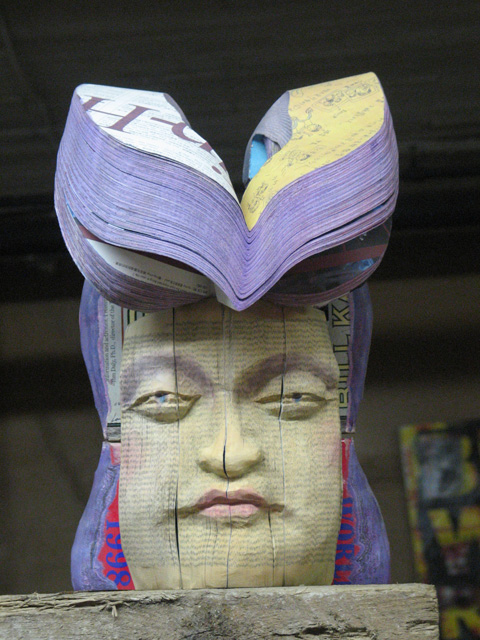
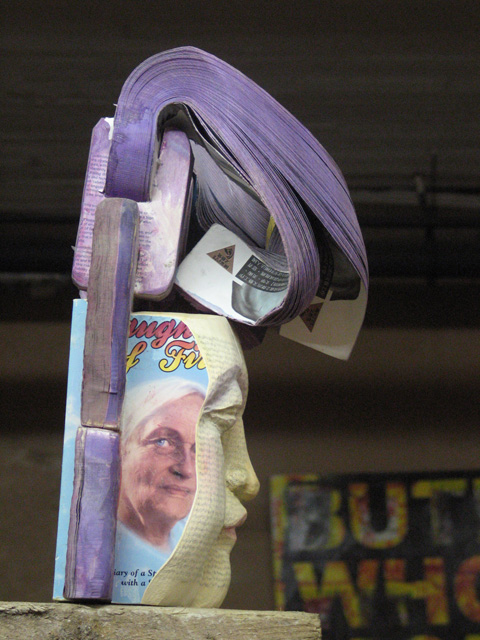
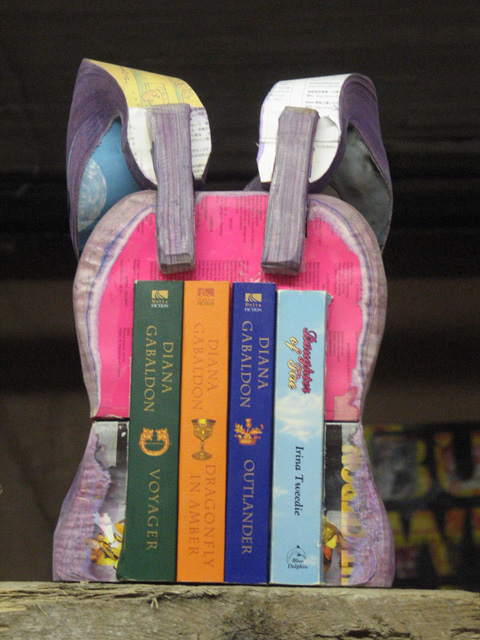

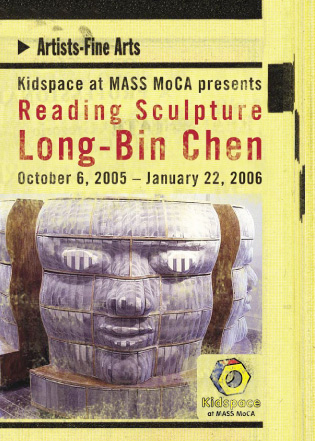
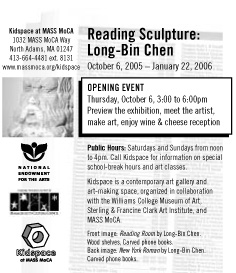
 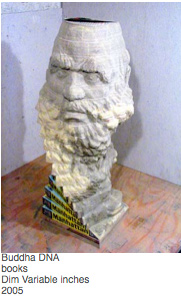 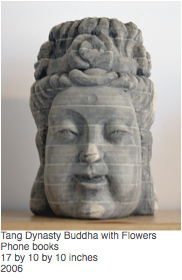
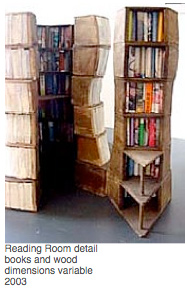 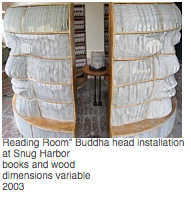
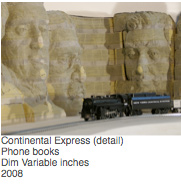
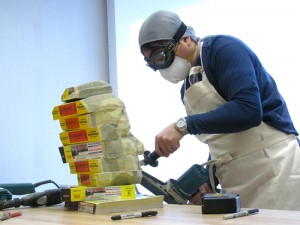
Long-Bin Chen at work in the MAD studios.
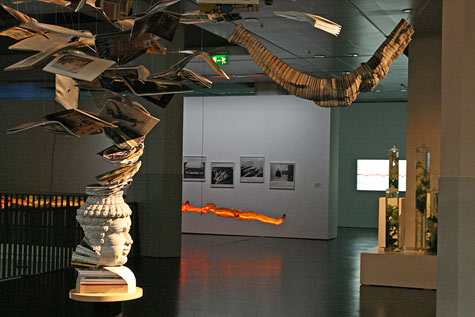
Long-Bin Chen: Buddha Hurricane
Long-Bin Chen’s work has always combined cultural contexts—East and West—and artistic forms—sculpture and literature. He makes plastic art out of literary art, re-creating something new out of something old (discarded books), and inspiring a new way to look at books. We are prompted not only to think about our cultural debris and the eternal problem of communication, but now also of the social relationship we have with books.
Chen’s work has also always had a sense of humor, and his new work takes its name playfully from Facebook. Inspired early on as student by Marshall McLuhan’s media theory that “the medium is the message,” that influence takes mature form in Chen’s most recent work. Where McLuhan’s radical theories in the 1970s talked about the steps from tribal pre-alphabetical writings through to the electronic age and radically predicting television as the new art form, Chen imagined McLuhan relevant again in the 1990s with the advent of the World Wide Web. The Chinese first wrote on oracle bones (the insides of turtles’ backs), then inside a bamboo stick, then on paper. It was the invention of print media and of movable type that has shaped the work of both McLuhan and Chen.
With the arrival of the personal computer, books as things became unwanted, unnecessary, and were discarded. And Long-Bin Chen had an idea: books themselves as the media, the form, and the art. The medium as message, relevant again (or, more importantly, relevant still: an organic theory being most scrupulous and honorable). As he walked around New York, he noticed more and more discarded books. So he’d go around on recycling day looking for them. He noticed an inordinate amount of discarded telephone books and the beginning of his career is filled with sculptures made out of the New York City telephone book. The idea being to give them life again. Nowadays he has no want for books, of all kinds. He finds piles on the streets on recycling day; people, charities, libraries, and professors donate entire collections. And no one’s buying them, independent bookstores can’t stay open. Long-Bin looks at his work as giving the book a second life. Could his work be preparing for THE END OF THE BOOK? Will libraries become museums? In 2004, Chen had a solo show in Rome and he visited the St. Ivoalla National Archive, only to notice that the books were on display. It felt to him like a museum, not a library. The books had no function other than to be looked at as things. This idea of books as art, or artifice, is not limited to historical archives.
Iam thinking of the pretentious reader: the one with all the “right” books on his shelf, the one who dresses the part and wears horn-rimmed glasses, the one with The Pale King out on his coffee table in the Hamptons but who can’t speak a word about it. Again: books as art. Chen started what he calls “cutting books” in 1993 in order to give books a second life. He turns to Walter Benjamin for sanction. In an article on shelving his library, Benjamin says, “to a true collector, the acquisition of an old book is its rebirth” [p. 61]. He believes that acquiring a second-hand book is a process of renewal and the most distinguished trait of that process of “transmissibility”. It is a lovely idea of inheritance and succession, and in that way carries with it a crucial social element.
And with that a social network? Chen’s exhibit, Bookface, may joke on the word and social world of Facebook, but it’s not mere wordplay. Think of the telephone book as a small world, all the people interconnected within it. Similarly, the Web and social networks: their own little worlds. But each one has a member, connected to another; each is its own small society; each has meaning for the members inside. The Luddite idea that the computer and the Web and social networks have isolated people is exactly wrong: it has connected them. If you look back over Chen’s career, most of his sculptures are of faces.
So why the face? Why not make a sculpture of a chair or a car? Further, why the Buddha face? First of all, the face is where the brain is, says Chen. The media of the book needs the brain, the head. The book’s “face” is in the back, the human face, on the other side. As for the Buddha, that explanation goes back to his days in art school. Firstly, being Chinese, Buddhism was part of his culture. When he came to the United States in 1992 to the School of Visual Arts in New York, his classes were so full of discussion on postmodern art and all its various bickering theories that he became unable to speak or respond; everything became too difficult, chaotic, and to the point where language could not respond. Long-Bin shut down, shut his book, turned it over, and began cutting.
He relates the story of Zen Master Huineng: a provincial, poor, illiterate, kitchen laborer, who became the founder of the Buddhist school of “Sudden Enlightenment” and is now studied as the mainstream Zen school in China. So the young student Chen, culture shocked, quiet in broken English, frustrated with postmodernism, turned to the Buddha face. And within two years became one of the two chosen out of about 35 in his class to represent his entire department... And now, in line with Walter Benjamin, whose article on unpacking his library, imagined his shelves as dwellings for his books, Long-Bin has incorporated shelves into his new work. It is a new and major development in Chen’s illustrious career. Instead of scouring the streets for books (they are now donated by the truckload), he hunts for second-hand bookcases. And they are readily available on garbage night in New York. What is different about this new project is that it takes up less space, incorporates furniture, and is more detailed and refined than his earlier works.
Books, for Chen, are still seen in terms of their shape, color, font, material and space (where most of us see them for their words and meaning). And there is, as always, a link to text; this time the books are matched to its shelf by topic.
The idea that language is an impossible means of expression is a paradox with which postmodernists continuously struggle. Meanwhile, Chen has constructed a message out of the medium worthy of Marshall McLuhan’s recognition. Making something new out of something old. And if “only in extinction is the [book] collector comprehended,” Chen’s art will keep it alive... for art collectors too.
CURRICULUM VITAE
Born in Taipei, Taiwan, 1964
Education
1994 MFA, School of Visual Art, New York, NY
1987 BFA, Tung-Hai University, Dept. of Fine Art, Taiwan
1983 Graduated from Fu-Shin Commercial and Technical School, Dept. of Fine Art, Taipei, Taiwan
Solo Exhibitions
2008 "Continental Express", Frederieke Taylor Gallery, New York, NY
2006 "Buddha Hurricane", Frederieke Taylor Gallery, New York, NY
2005 "Buddha DNA", Frederieke Taylor Gallery, New York, NY
2005 "Reading Sculpture-LA Project", Lowe Gallery, Los Angeles, CA
2005 "Reading Sculpture-Kids Project", Kidspace at Mass MOCA, North Adams, MA
2004 "Reading Sculpture-Roma Project", Galleria Ca'a d'Oro, Roma, Italy
2004 "Reading Sculpture-Milan Project", Galleria Ca'a d'Oro, Milan, Italy
2004 "Reading Sculpture-Vermont Project", Vermont Studio Center, VT
2004 "Reading Sculpture-Atlanta Project", Lowe Gallery, Atlanta, GA
2003 "Reading Sculpture", Frederieke Taylor Gallery, New York, NY
1999 "Alternative Study", Eslite bookstore, Taiwan
1998 "Taiwan Study", Cultural Affairs Department of Taiwan Provincial Government, Taiwan
1997 "Humanity", Taipei Fine Art Museum, Taipei, Taiwan
1995 "Reading Sculpture", Eighth Floor Gallery, New York, NY
1994 "Culture Empire", American Institute in Taiwan, Taipei, Taiwan
1992 "Tools", Space 2 Gallery, Taipei, Taiwan
Group Exhibitions
2008 Holland Paper Biennial, Museum Rijswijk, Holland
2008 CODA Museum, Apeldoorn, Holland
2008 Outside In: A New Focus on Taiwanese Art, Columbia University and TECO, Taipei CUltural Center, Taipei, Taiwan
2008 "Text Messaging", Islip Museum of Art, New York, NY
2008 "Second Lives: Remixing the Ordinary", Museum of Art and Design, New York, NY
2007 Pulp Function, FUller Craft Museum, Brockton, MA
2007 Thermocline of Art-New Asian Waves, Germany
2006 "Extreme Materials", Memorial Art Gallery, Univeristy of Rochester, NY
2006 Pacific Rim, City of Brea art gallery, Brea, CA
2005 "The Missing Peace: Artists Consider the Dali Lama", organized by the Dali Lama Foundation, Fowler Museum, UCLA (2006); Loyola University Museum of Art, Chicago, Rubin Museum of Art, New York. Exhibition to travel to international cities including: Paris, Berlin, London, Taipei and Tokyo.
2004 "Artist Book", Plum Blossoms Gallery, New York, NY
2003 "Invisible Thread", Snug Harbor Cultural Center, New York, NY
2001 "Absolut-2001 Los Angeles International, Biennial Art Invitational", Robert Berman Gallery, Santa Moncia, CA
1999 "Volume & Form Singapore 1999", Singapore City, National Library, Singapore
1999 "Paper-Play Factory-International Paper Art Festival", Cheng Chuen Cotton Paper Foundation & Cultural Affairs Department Taiwan Provincial Government, Taiwan
1999 Sculpture to Wear Gallery, Santa Monica, CA
1999 San Francisco Art Fair, Robert Berman Gallery, San Francisco, CA
1998 "Osaka Trienniale 1998-Sculpture", Osaka Contemporary Art Center, Osaka, Japan
1998 "Gateway to Wisdom", Fubon Art Foundatio, Taiwan University, Taipei, Taiwan
1998 "New Voices: Contemporary Art Dialogue Among Taipei, Hong Kong and Shanghai", National Taiwan Arts Education Institute, Taipei, Taiwan
1998 Art Fair, Fubon Art Foundation, Taipei, Taiwan
1997 "Feast of Mind, Buffet of Art", Fubon Art Foundation, Taipei, Taiwan
1996 "Our Deities", ISE Art Foundatio, New York, NY
1996 "Personal Best", Chassie Post Gallery, Atlanta, GA
1995 "A Dialogue of Contemporary Sculpture in Asia", Taipei FIne Arts Museum, Taipei, Taiwan
1995 "Object Orbit", Chinese-American Arts Council, New York, NY
1995 "obCkession", TZ'art & Co., New York, NY
1995 "Triennial der Kleinplastick 1995, Europ-Ostaien", Suttgart, Germany
1995 "America vs. China", window dressing, TZ'art & Co., New York, NY
1994 "New York area MFA exhibitioin", Hunter College, Co-sponsored by CAA, New York, NY
1994 "The Entering Show of Taipei Fine Arts Museum Biannual", Taipei, Taiwan
1994 "Ross Chambers, Long-Bin Chen and John Lavin", SVA Gallery, New York, NY
1994 "Taiwan Map", window dressing, Dimension Art Center, Taipei, Taiwan
1993 "Curious Structures", Visual Art Gallery, New York, NY
1993 "Play, Work, Thing", Visual Art Gallery, New York, NY
1992 "Time Duration", Dimension Art Center, Taipei, Taiwan
1992 "Selling Specialty", Go Go Gallery, Taipei, Taiwan
1992 "Can Art Be Heritable?", Space 2 Gallery, Taipei, Taiwan
1991 "The 5th International Print Biannual of Taiwan", Taipei Fine Art Museum, Taipei, Taiwan
1991 "Vernacular", Space 2 Gallery, Taipei, Taiwan
1987 "Shih Hsing New Artist", Shih Hsing Gallery, Taipei, Taiwan
Awards
2003 Freeman Foundation Fellowship
2001 Grant of the Nation Endowment for Arts, Taiwan
1998 1998 Grant of the Nation Endowment for Arts, Taiwan
1998 The Silver Prize of Osaka Triennial 1998 (Sculpture), Osaka, Japan
1997 1997 Grant of the Nation Endowment for Arts, Taiwan
1996 1996 Grant Award of the Joan Mitchell Foundation, New York, NY
1995 Visitors Prize of the 6th Triennial of Small Scale Sculpture, Stuttgart, Germany
1988 Tung-Hai University Fine Arts Prize, Taiwan
1987 12th Shih Hsiung New Artist Prize, Taipei, Taiwan
1985 Awarded National Print Prize, Taiwan
Residencies
2005 Mass MOCA Residency
2004 Vermont Studio Residency
2003 Snug Harbor Cultural Center Resident Artist
2000 18th Street Arts Complex
|